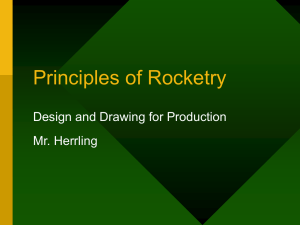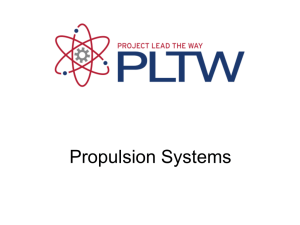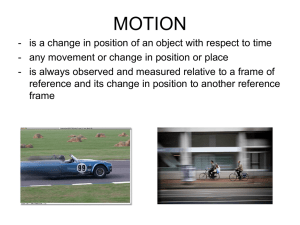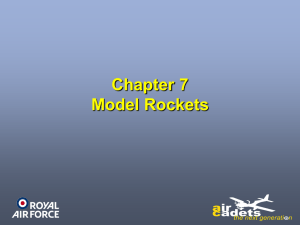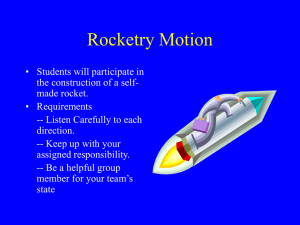Rocketry
advertisement
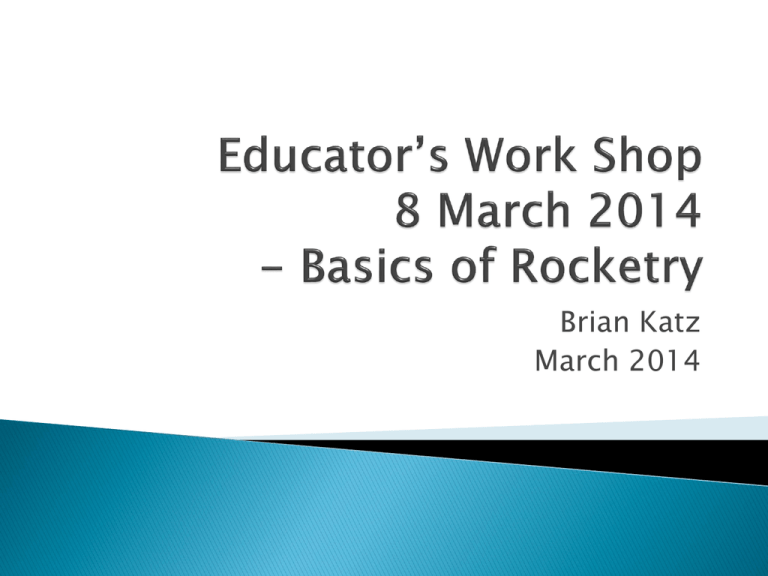
Brian Katz March 2014 Space/Rocket Curriculum Goals ◦ Provide Information About Space, Science, Rocketry and Transportation Machines ◦ Stimulate Interest in School/Learning/Goals/Better One’s-Self ◦ Promote Open Discussions, Allow Students To Think, Express and Brainstorm ◦ Teach Students How To Follow Instructions and Complete a Project working together as a team (Build and Possibly Launch a Rocket) Sessions ◦ #1: History of Space Travel ◦ #2: Orbits and Gravity ◦ #3: General Rocketry ◦ #4: Rocket Design ◦ #5: Build Rocket(s) ◦ #6: Launch Session Formats ◦ Imagery (online videos): “Fire and Smoke” ◦ Rocket building project and launch (rocket derby) Goal ◦ Familiarize Students with the Fascinating History of Rocketry ◦ Talk about how to accomplish a “big” project – break it down into sub sections and accomplish piece by piece (Mercury/Gemini/Apollo) See attachment 1: History of Space Travel Presentation – walk through this Videos: ◦ http://www.youtube.com/watch?v=kEdtvct6Tf0 ◦ http://www.youtube.com/watch?v=8y3fIr4dVYE&feature=related ◦ http://www.youtube.com/watch?v=awyuMF9rYhQ ◦ http://www.youtube.com/watch?v=CdQFZRJhkCk ◦ http://www.youtube.com/watch?v=vFwqZ4qAUkE Side topics/discussions: ◦ Balloons, Airplanes, Helicopters, Rockets – Why/How Do They Fly ◦ Emphasize Ingenuity/Motivation to Create Digress – Find Their Interests, Search For Ideas, What Have they ever built, want to build, etc… ◦ Watch October Sky and Apollo 13 Goal: ◦ Instruct Students on where we are going – to space, what is space? Discuss Orbit, Gravity and Atmosphere ◦ Orbit: What is an Orbit: Show Video With Canyon Ball: http://spaceplace.jpl.nasa.gov/en/kids/orbits1.shtml ◦ Gravity: a. Talk about how ideally, all masses fall to ground at same acceleration; discuss big rock/little rock when dropped will hit ground at the same time b. Talk about gravity around all planets/moons c. Discuss table of relative body weights on other planets ready d. Show video of Astronauts In Space Shuttle and explain that they are floating because they are FALLING!! Use dropping elevator scenario or the dropping airplane scenario ◦ Atmosphere: ◦ Talk about friction, rub hands together for younger kids Relative weights of objects on planets Mercury 0.38 Venus 0.91 Earth 1 Mars 0.38 Jupiter 2.54 Saturn 1.08 Uranus 0.91 Neptune 1.19 Pluto 0.06 Moon 0.6 Goal ◦ Instruct Students on General Rocketry – what are rockets, their uses, their operation principles Basic Operation ◦ How/Why Rockets Fly – fire/smoke out the backend – equal and opposite reaction, payload upfront, separation of stages – why? ◦ Temperatures/Speeds/Materials ◦ Newton’s Laws (see next slide) Digress – Talk about science, science laws and our world 1st Law (Inertia): ◦ “In the absence of contrary forces, the speed and direction of an object’s movement will remain constant.” Explanation: The force generated by the escaping gasses from the rocket motor must be great enough to lift the rocket’s total mass from the launch pad, or it will not fly. 2nd Law (Acceleration): ◦ “A body that is subject to forces moves at a speed which is proportional to the amount of force applied.” Explanation: The greater the force supplied by the rocket motor, in relation to the total mass of the rocket vehicle, the faster it will go. 3rd Law (Action/Reaction): ◦ “For every force action there is an equal and opposite reaction.” Explanation: Release of gases through the nozzle (action) produces a force on the rocket (reaction) in the opposite direction, causing the rocket to accelerate. From Newton’s 2nd Law (motion of the Rocket)- F ma Where: F = force m = mass a = acceleration The rocket motor’s total energy is called its total “Impulse” and is a measure of rocket motor’s overall performance Impulse is the sum (or integral) of total force imparted over the time it acts upon the rocket: I Total T 0 Fdt or Where: F = force history profile T = Total time I Total F T Goal: ◦ Dig in deep to rocket design - learn the major components and systems ◦ Discuss Design, Analysis, Test, Build Discussion: ◦ Propulsion (Solid, Liquid) ◦ Fins – why do we need them ◦ Nose Cone – Aerodynamics and payload protection ◦ Nozzle – essence of the propulsion system ◦ Igniter – gets it all started Operation ◦ How do we Maneuver Rockets ◦ Flight Termination ◦ Countdown/procedures Show Rockets That Didn’t Make It Video ◦ http://www.youtube.com/watch?v=13qeX98tAS8 ◦ What can we learn from this video? By 1926, Goddard had constructed and tested successfully first rocket using liquid fuel on March 16,1926, at Auburn, Massachusetts. Rocket used cylindrical combustion chamber with impinging jets to mix and atomize liquid oxygen and gasoline The rocket, which was dubbed "Nell", rose just 41 feet during a 2.5-second flight that ended 184 feet away in a cabbage field US and German engineers quickly ran with this idea and greatly expanded on the technology Liquid vs Solid Propulsion Systems Turbo Machinery Boost Pumps Main Pumps Injector Igniter Combustion Chamber Nozzle Heat Exchanger Mixture and throttle Valves Pneumatic actuation, pressurant, and purge systems Rocket Equation Variables: q = ejected mass flow rate Ve = exhaust gas ejection speed Pe = pressure of the exhaust gases at the nozzle exit Pa = pressure of the ambient atmosphere Ae = area of the nozzle exit At = throat area of the nozzle m0 = initial total mass, including propellant m1 = final total mass ve = effective exhaust velocity go = Gravitational Constant Pc = Chamber Pressure F (ThrustVac) = Force produced by the engine at 100% throttle in a vacuum environment Δv = maximum change of velocity Isp = Ratio of the thrust to the ejected mass flow rate used as the primary efficiency measure C* (C-Star) = characteristic exhaust velocity term used as a primary engine development value ◦ Major Components ◦ ◦ ◦ ◦ ◦ Injector Structural Jacket Coolant Liner Coolant Inlet Manifold Nozzle extension attachment Design Considerations ◦ ◦ ◦ ◦ ◦ ◦ ◦ Oxidizer / Fuel Mixing Ignition Flame Holding Cooling Weight Manufacturability Engine Integration Combustion Chamber Nozzle is Tightly Integrated with Combustion Chamber Nozzle can be an awkward part of engine that makes packaging difficult ◦ Extendable Nozzles are complicated and expensive, (Delta 4 and Arianne upper stages are examples) ◦ Fixed nozzles are bulky and extend vehicle length, and increase re-contact risks Nozzle Cooling is commonly Achieved by ◦ Ablative materials ◦ Regenerative cooling ◦ Film Cooling Nozzle Hypergolic: fuels and oxidizers that ignite spontaneously on contact with each other and require no ignition source Nitrogen Tetroxide (NTO, N2O4). redfuming nitric acid N2H4 - Hydrazine UDMH – Unsymmetrical dimethyl hydrazine (Lunar lander RCS UDMH/N2O4) Aerozine 50 (or "50-50"), which is a mixture of 50% UDMH and 50% hydrazine MMH (CH3(NH)NH2) Monomethylhydrazine NTO/Aerozine 50 for Delta II second stage NTO/MMH is used in the Shuttle OMS http://en.wikipedia.org/wiki/Liquid_rocket_pr opellants Propellants Simplest of the Power Cycles No turbo-machinery making it one step up in complexity over solid motors Requires high pressure tank structure to provide sufficient inlet pressures Common for hypergolic engines which also eliminates the need for an ignition source Chamber pressures ~100 to 200 psi AJ-10 uses NTO/A50 ◦ ISPVac 271 Sec ◦ 7.5k lbs thrust Space X Kestrel uses LOX/RP-1 ◦ ISPVac 317 Sec ◦ 6.9k lbs of thrust Pressure Fed System Engines are commonly tested at ground level, usually in vertical configuration or horizontal configuration with slight slant Upper stage engines are commonly testing in altitude chambers Exhaust gas flow detachment will occur in a grossly over-expanded nozzle. Underexpanded Optimum Overexpanded ThrustVac : 750,000 lbf (3.3 MN) Burn Time: 470 s Design: Gas Generator cycle Specific impulse: 410 s Engine weight – dry: 14,762 lb (6696 kg) Height: 204 in (5.2 m) Diameter: 96 in (2.43 m) Ground systems for liquid rockets are commonly more complex than the rocket itself Atlas V pad has accommodations for LOX, RP, H2, N2, and He Extensive plumbing, tanking and detanking capabilities Electrical control to ensure proper filling and top-off Significant leak, thermal, flammability, oxygen deficiency and explosive concerns Day of launch operations are extensive and very dynamic during preparation, fueling, monitoring, top-off, startup verification, liftoff disconnects, and possible shutdown and de-tanking operations Solid Propulsion Liquid Propulsion vs o Discuss: - Vastness of these engineering marvels – as tall as a 10 – 20 story building - Attention to detail, ask questions, learn, communicate with each other Atlas V Delta IV Heavy Delta II Falcon 9 Antares o Discuss: - Solid Propellant details - Concept of ground testing – why? Convert chemical energy to heat ==>> Movement of heated gases ==> Energy of motion (Burning Propellant) (through Nozzle exit) (Imparted Force) Exhaust Nozzle Cut-away view of a typical Rocket Motor Ignitor Propellant Motor Case o Discuss: - There are lots of different types of engineers who work with rockets – we work as a team Flight Computer Guidance/Navigation and Control Electrical Power Thrust Vector Control RF o Discuss: - Why Do we need Flight Termination? - Why Do we need separation mechanisms? Flight Termination Payload Separation Stage Separation Goal: ◦ Build Rockets/team work/follow instructions – team work Build Ideas: ◦ Students Read Out loud Instructions ◦ Students Initial Steps Complete ◦ Students Perform Quality Inspections Launch Ideas: ◦ Create Launch Countdown Checklist and Have various students perform duties Test Conductor Pad Chief Range Safety Officer Counter





